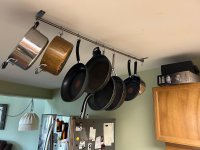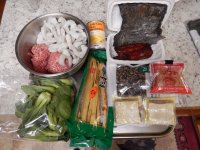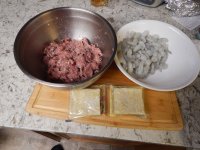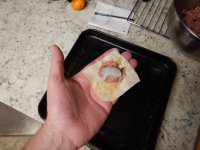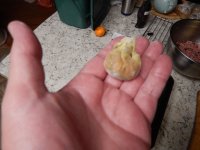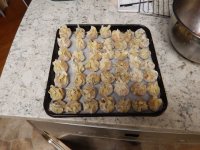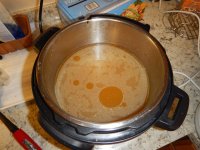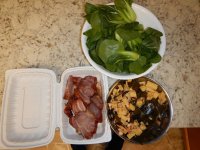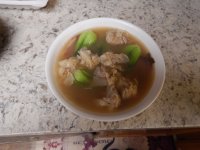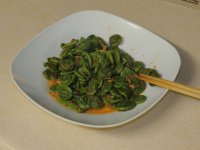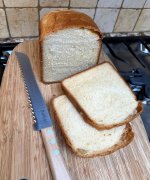Oh and whilst the oven was on roasted some golden beetroot ready for lunch tomorrow. Yum.
I‘m certainly a believer in that.I realized I has enough of rummaging through cupboards and shelves for pots and pans. I
Attachments
Last edited:
Burbank russet is named after a person not a place though.
So was the city. I think they were brothers.
Anyway, it was just guess of what was meant by California Russet.
So was the city. I think they were brothers.
Anyway, it was just guess of what was meant by California Russet.
Burbank is in the greater LA area, and 19 km from downtown LA.
Wiki is interesting.
Famous for Lockheed, Northrop and Hughes in aviation.
Also main center for entertainment, lots of adult studios as well.
The association in my mind was from Burbank Russet, like Cal said, I thought it was a variety originally from California.
The potatoes from Hawaii are said to have a higher sugar content than normal, nice brown color on frying, and maybe the weather / soil combination adds to its qualities.
In any case, there were artisanal chip shops selling fried potatoes to tourists in Hawaii, and like Cal says, may be advertising hype rather than reality.
Wiki is interesting.
Famous for Lockheed, Northrop and Hughes in aviation.
Also main center for entertainment, lots of adult studios as well.
The association in my mind was from Burbank Russet, like Cal said, I thought it was a variety originally from California.
The potatoes from Hawaii are said to have a higher sugar content than normal, nice brown color on frying, and maybe the weather / soil combination adds to its qualities.
In any case, there were artisanal chip shops selling fried potatoes to tourists in Hawaii, and like Cal says, may be advertising hype rather than reality.
This intrigued me so I had to check. Apparantly they were not. Luther Burbank was an interesting guy. He used the money made from selling the rights to the spud to move to California where he created the Shasta daisy amongst other things. I grow those in memory of my sister.So was the city. I think they were brothers
Continuing on a spud theme I was never a huge fan of new potatoes other than in potato salad, but we have found they are very good in Indian sabji as they don't go mushy when cooked in the gravy. I fear I will end up needing to keep 3 types of tuber in the larder to cover the bases...
This intrigued me so I had to check. Apparantly they were not. Luther Burbank was an interesting guy. He used the money made from selling the rights to the spud to move to California where he created the Shasta daisy amongst other things. I grow those in memory of my sister.
He moved to Santa Rosa CA -- and the Luther Burbank Home and Garden is worth a visit. In fact, there is also an experimental garden you can wander through a short distance from the original site.
He grew an orange with the consistency of a golf-ball -- it was bitter but could withstand the winters, has a peculiar pherome when blossoming.
Here's something I haven't made for a while. Maybe it's time.
Attachments
This would be mine.If I could have only one vegetable for the rest of my life, it would be a potato.
Attachments
Made Japanese ("Hokkaido") milk bread in the Hamilton Beach machine this morning. It's extremely difficult to find the traditional Japanese large cross section (10 x 15 cm) loaf pans in the US, and we decided the American Pullman loaf pans were just too small (11 x 11 cross section); their baked result simply wasn't "Japanese milk bread".
Luckily the HB bread machine is sized almost perfectly, to get authentic 10 x 15 slices. This morning we used Javier Tan's recipe found online: salt, sugar, yeast, high gluten bread flour, milk, butter, egg, powdered dry milk. I enjoyed some of the bread at lunchtime and it was delicious, exactly what I was shooting for.
_
Luckily the HB bread machine is sized almost perfectly, to get authentic 10 x 15 slices. This morning we used Javier Tan's recipe found online: salt, sugar, yeast, high gluten bread flour, milk, butter, egg, powdered dry milk. I enjoyed some of the bread at lunchtime and it was delicious, exactly what I was shooting for.
_
Attachments
Might try using a "yudane" in your milk bread recipe, will allow it to hold more liquid and provide a fluffier result. Its not difficult to do, basically scalding a portion of the flour with boiling water to convert the starches. Very similar to a roux. Yudane I believe is more 1:1 flour to liquid. A "tangzhong" (Chinese equivalent) is more of a 4:1 or 5:1, but essentially the same thing. Use a portion of the flour and water from the original recipe.
Simple, but tasty lunch today. Tinned herring on toasted 5% rye SD with evoo, S&P.

Simple, but tasty lunch today. Tinned herring on toasted 5% rye SD with evoo, S&P.
This would be mine.
Fiddleheads are lovely. One of my favorite things to forage.
I've tried both and, like a surprising number of others, I find that I actually prefer the bread without tangzhong and without yudane. Here's a video from one such YouTube channel, Ethan Chlebowski's, talking about the comparison. His tasting panel preferred the no-tangzhong version.Might try using a "yudane" in your milk bread recipe, will allow it to hold more liquid and provide a fluffier result. Its not difficult to do, basically scalding a portion of the flour with boiling water to convert the starches. Very similar to a roux. Yudane I believe is more 1:1 flour to liquid. A "tangzhong" (Chinese equivalent) is more of a 4:1 or 5:1, but essentially the same thing. Use a portion of the flour and water from the original recipe.
Yeah, for shokupan it can change the flavor profile a little, its really best in highly enriched breads, things with a lot more sugar and fats (approaching 30%) like pastries and dessert breads. But, the important thing is you tried it! I have never used it with a yeasted bread before, either.
Try baguette flour, with a little of the water from slightly sour yogurt added at kneading time, let it stay for at least an hour about 30 C ambient, adjust for local conditions.
Baguette flour refers to the flour used for the crusty French loaf, winter durum wheat flour IIRC.
Baguette flour refers to the flour used for the crusty French loaf, winter durum wheat flour IIRC.
From what I know, baguettes are made with strong flour (12-14% protein, aka bread flour), however it is a staple crop grown worldwide and varies greatly regionally. EU plain flour is consistent with low strength bread flour in the US. Bread flour here is typically 11-14% protein, though most I've seen are 11.5-13%. Starter strength, or yeast quantity play a bigger role than many think.
Her name was Daisy?This intrigued me so I had to check. Apparantly they were not. Luther Burbank was an interesting guy. He used the money made from selling the rights to the spud to move to California where he created the Shasta daisy amongst other things. I grow those in memory of my sister.
Try kumera / sweet potatoes. Absolutely lovely flavour and they keep really well compared to the humble Murphy.Continuing on a spud theme I was never a huge fan of new potatoes other than in potato salad, but we have found they are very good in Indian sabji as they don't go mushy when cooked in the gravy. I fear I will end up needing to keep 3 types of tuber in the larder to cover the bases...
do use sweet potatoes. Mainly roasted for soup or in mash or pasty filling. They don't seem to hold together well in a sabji. Should try and find more uses for them.
Thomas Keller's green lentils and sweet potatoes is a killer recipe, from his Ad Hoc at Home cookbook. We absolutely love it. (link)
Studiously creating the cartouche (parchment paper lid) for these lentils, makes you feel a little bit like a line cook at The French Laundry
_
Studiously creating the cartouche (parchment paper lid) for these lentils, makes you feel a little bit like a line cook at The French Laundry
_
I did used to use the parchment method for sweating the veggies but got lazy as I got older. Not considered sweet potato with lentils other than as part of a salad though.
Dear Mr Grammar cop,do use sweet potatoes.
We just slice/chip them and bung them in the air frier with rapeseed oil, garlic, salt, chilli flakes and smoked paprika. 10 minutes full blast. Simple's.
PS: Do sentences usually start with a capital letter, and, is your reply a command?
- Home
- Member Areas
- The Lounge
- The food thread
